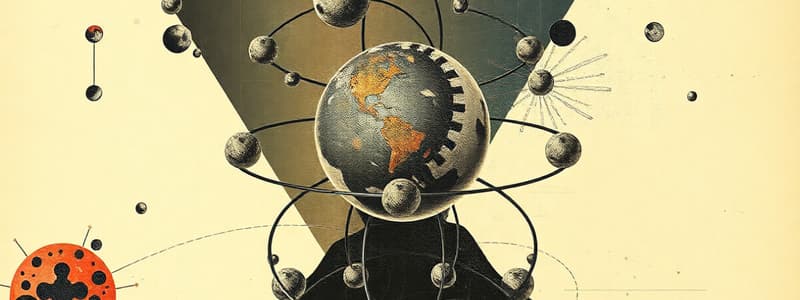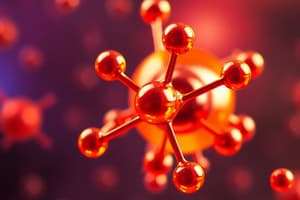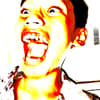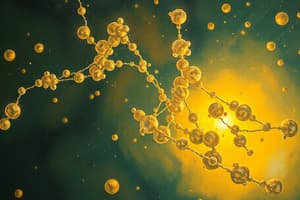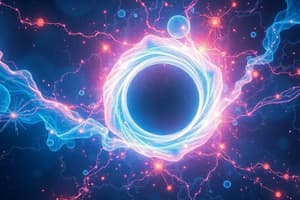Podcast
Questions and Answers
What is the name of the Greek philosopher who first proposed the concept of the atom?
What is the name of the Greek philosopher who first proposed the concept of the atom?
Democritus
What are the three basic particles that atoms consist of?
What are the three basic particles that atoms consist of?
- Quarks, Leptons, and Bosons
- Nucleons, Electrons, and Quarks
- Protons, Neutrons, and Electrons (correct)
The nucleus of an atom is positively charged due to the presence of protons.
The nucleus of an atom is positively charged due to the presence of protons.
True (A)
What are protons and neutrons collectively called?
What are protons and neutrons collectively called?
What is the name of the model of an atom that proposes protons and neutrons are in a central nucleus with electrons orbiting around it?
What is the name of the model of an atom that proposes protons and neutrons are in a central nucleus with electrons orbiting around it?
Electrons are negatively charged particles found orbiting the nucleus of an atom.
Electrons are negatively charged particles found orbiting the nucleus of an atom.
What is the charge of a proton?
What is the charge of a proton?
What is the charge of an electron?
What is the charge of an electron?
Atoms are the basic units of matter and they are defined by chemical elements.
Atoms are the basic units of matter and they are defined by chemical elements.
What does the atomic number of an element represent?
What does the atomic number of an element represent?
What is the name for the smallest identifiable unit into which a pure substance can be divided while retaining its composition and chemical properties?
What is the name for the smallest identifiable unit into which a pure substance can be divided while retaining its composition and chemical properties?
Water is a good example of a molecule, as it is made up of two hydrogen atoms and one oxygen atom.
Water is a good example of a molecule, as it is made up of two hydrogen atoms and one oxygen atom.
Flashcards
What is matter?
What is matter?
Anything that occupies space and has mass.
What does matter refer to?
What does matter refer to?
All substances that make up the universe.
What are atoms?
What are atoms?
Minute and indestructible particles that make up all matter.
What are atoms considered to be?
What are atoms considered to be?
Signup and view all the flashcards
Who is Democritus?
Who is Democritus?
Signup and view all the flashcards
What is a molecule?
What is a molecule?
Signup and view all the flashcards
What is Chemistry?
What is Chemistry?
Signup and view all the flashcards
What is a vacuum?
What is a vacuum?
Signup and view all the flashcards
How can matter be classified?
How can matter be classified?
Signup and view all the flashcards
What is a pure substance?
What is a pure substance?
Signup and view all the flashcards
What is a mixture?
What is a mixture?
Signup and view all the flashcards
What is the nucleus of an atom?
What is the nucleus of an atom?
Signup and view all the flashcards
What are protons?
What are protons?
Signup and view all the flashcards
What are electrons?
What are electrons?
Signup and view all the flashcards
What are neutrons?
What are neutrons?
Signup and view all the flashcards
What is the atomic number?
What is the atomic number?
Signup and view all the flashcards
What is the mass number?
What is the mass number?
Signup and view all the flashcards
How do you find the number of neutrons in an atom?
How do you find the number of neutrons in an atom?
Signup and view all the flashcards
What is the nuclear model of an atom?
What is the nuclear model of an atom?
Signup and view all the flashcards
What is atomism?
What is atomism?
Signup and view all the flashcards
What is Dalton's Atomic Theory?
What is Dalton's Atomic Theory?
Signup and view all the flashcards
What is considered to be the basic unit of matter?
What is considered to be the basic unit of matter?
Signup and view all the flashcards
What is an element?
What is an element?
Signup and view all the flashcards
What is a compound?
What is a compound?
Signup and view all the flashcards
What is the charge of an ion?
What is the charge of an ion?
Signup and view all the flashcards
What is an ion?
What is an ion?
Signup and view all the flashcards
What is a physical property?
What is a physical property?
Signup and view all the flashcards
What is a chemical property?
What is a chemical property?
Signup and view all the flashcards
What is a physical change?
What is a physical change?
Signup and view all the flashcards
What is a chemical change?
What is a chemical change?
Signup and view all the flashcards
Study Notes
Matter
- Matter is anything that occupies space and has mass.
- All matter is made up of tiny, indestructible particles called atoms.
- Matter can be classified as pure substances or mixtures.
- A vacuum is any space that does not contain any matter.
Atoms
- Atoms are the basic units of matter.
- Atoms are composed of even smaller particles: protons, neutrons, and electrons.
- Protons have a positive charge, electrons have a negative charge, and neutrons have no charge.
- Protons and neutrons are located in the nucleus, which is the center of the atom.
- Electrons orbit the nucleus.
- The number of protons in an atom is its atomic number.
- The total number of protons and neutrons in an atom is its mass number.
- Democritus, a Greek philosopher, is considered a central figure in the development of the Atomic Theory.
Atomic Structure
- Atoms are composed of protons, neutrons, and electrons
- The nucleus is at the center of the atom
- Protons and neutrons are found within the nucleus
- Electrons are found in the space outside the nucleus
Subatomic Particles
- Protons (p+): positively charged particles found in the nucleus.
- Neutrons (n0): neutral particles found in the nucleus.
- Electrons (e-): negatively charged particles orbiting the nucleus in shells or orbitals.
Atomic Theory (Dalton)
- Each element is composed of extremely small particles called atoms.
- All atoms of a given element are identical, but atoms of different elements are different.
- Atoms of different elements combine in simple whole-number ratios to form chemical compounds.
- Atoms are neither created nor destroyed in chemical reactions.
Molecules
- A molecule is a group of two or more atoms bonded together.
- Molecules form by atoms combining.
- Molecules can be simple (like oxygen or water), complex (like caffeine), or have repeating units (like DNA).
- The composition of a molecule dictates its chemical properties.
How to Determine the Number of Protons, Electrons, and Neutrons
- Number of protons = atomic number
- Number of electrons = atomic number (in a neutral atom)
- Number of neutrons = mass number – atomic number
- The charge of the atom is the difference between the number of protons and electrons.
Atomic Number
- The atomic number is the number of protons in the nucleus of an atom.
- The atomic number uniquely identifies an element.
- The atomic number is located at the top of an element's box in the periodic table.
Chemical Bonding
- Chemical bonding happens due to the interactions between electrons in atoms.
- Bonding can be ionic, covalent, or metallic, which involve the sharing or transfer of electrons between atoms
Studying That Suits You
Use AI to generate personalized quizzes and flashcards to suit your learning preferences.
